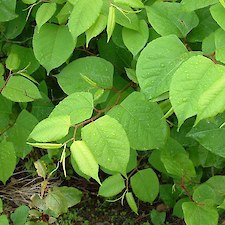 Asiatic knotweed
Asiatic knotweed
Common name: Asiatic knotweed
Botanical name: Fallopia japonica
Management programme: Progressive Containment
Asiatic knotweed is listed as one of the world’s worst invasive species by the World Conservation Union. Its invasive root system can extend 7m horizontally and up to 3m deep, making it incredibly difficult to control.
Why is it a pest?
- Asiatic knotweed grows to form dense thickets which expand rapidly, this crowds out the growth of native seedlings.
- It is a strong plant; it has the ability to damage building foundations and push up roads.
- Even if the foliage is sprayed with herbicide it rarely penetrates into the extensive root system. Plants will die back, then happily re-grow from the roots again in spring.
Where is it found?
Rotorua has the majority of known sites in the region. Several sites are known in western Bay of Plenty and a single recorded site in eastern Bay of Plenty. All known sites are currently under Council management.
Asiatic knotweed grows in any conditions but is typically found along waterways where seeds have been able to drop from the parent plant and re-establish downstream via water flows. It can also be spread by human activity - root fragments become disturbed and hitch rides on machinery, gardening tools or garden waste.
At risk areas include roadsides, railway corridors, riverbanks, and forest margins.
What does it look like?
- Broad heart or shovel shaped leaves.
- Small, white flowers in drooping clusters, seen December to March.
- Stems grow in a zig-zag pattern, are a reddish purple when young then become green and hollow once matured.
- Glossy brown fruit ~3mm long follow flowering.
What are the rules?
Progressive Containment
Progressive Containment species are pests which the council aims to prevent from spreading, reduce the distribution, or eradicate within parts of the region over time.
As this plant is very difficult to control, the council will maintain control and management of Asiatic knotweed.
How do you get rid of it?
Don’t attempt to control yourself. Let us know if you think you have seen Asiatic knotweed or have it on your property. If you can, take a photo, note its location and send the details through by emailing stop.pests@boprc.govt.nz or alternatively call 0800 884 880.
Images








